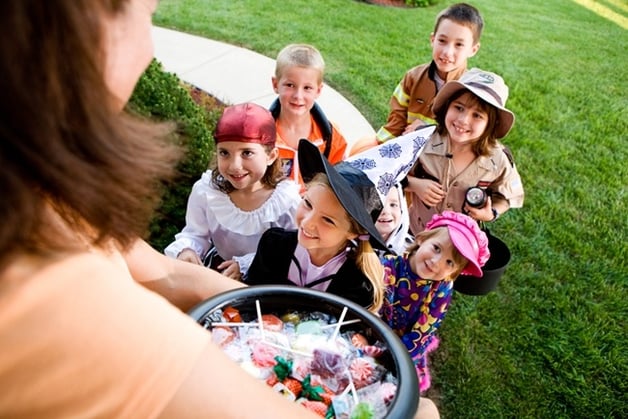
On Halloween, the streets will be packed with all sorts of monsters and goblins trick-or-treating their way around the neighborhood. While they stock their bags with Halloween goodies, they may also fill their mouths with cavities. In fact, 42 percent of children between the ages of 2 and 11 experience dental cavities in their primary teeth.1 Don't be fooled by the thought that baby teeth aren't important - they can help control the growth patterns of permanent teeth. Keeping a healthy smile is crucial at all ages, so make sure you set a mouth-smart strategy this Halloween with your kids as part of your family dental plan:
"Avoid gooey caramel-filled treats."
Pick the right treats
Though Halloween is certainly a night filled with magic, there's no enchantment that can make a piece of candy healthy. However, some options are better than others. Avoid gooey caramel-filled treats that are more prone to getting stuck between teeth. Caramel is mostly made of sugar, and the longer it adheres to the tooth's surface, the more damage it can cause. When you eat sugar, it reacts with plaque, which is the bacteria already present in your mouth, to create acid.2 The acid eats away at the tooth's enamel and causes it to lose minerals, which is worsened with frequent and prolonged acid attacks.
Instead, go with sugar-free candy or other options packed with more nutrients. For example, dark chocolate has less sugar than milk chocolate, and it's chock full of antioxidants and flavonoids due to its higher concentration of actual cocoa content. These elements are believed to aid the body in resisting damage caused by free radicals and may lower blood pressure and improve circulation.3
Sugar-free gum is another favorable option for Halloween candy. It may actually promote better dental health, too. It can remove food particles stuck between the teeth and increase saliva production, a vital tool for fighting dental decay.
Eat it at once
After a night of trick-or-treating, your kids will likely want to dive into their candy and eat it all at once. When it comes to dental health, that may be the best option. Again, the more frequently those acid attacks occur, the greater the damage they can cause to the enamel. As such, it's best to consume sugar in one sitting rather than intermittently throughout the days following Halloween. Of course, eating too much at once can make anyone sick. Just be conscious of this fact and plan the candy indulgence accordingly.
Practice proper oral hygiene
Immediately after your kids eat candy, have them brush and floss their teeth. This will essentially stop the acid attacks from occurring. Of course, you can't prevent the damage done while they munch away on their sweets, but you can certainly reduce the impact once they're finished. After all, acid attacks last for about 20 minutes, which provides plenty of time to brush and floss.

Plan fun activities instead of eating candy.
Swap out the sweets
If you let your little ones pig out the night of and want to avoid candy eating in the days following Halloween, considering swapping out sweets for non-food treats. Colgate recommended allowing your child to trade in a piece of candy in exchange for a toy he or she wanted or an activity your child has been wanting to do.4 This method lets your kids still have fun while making healthier choices.
Schedule a dentist appointment
Though dentist appointments are usually scheduled six months apart, try to make yours before the holiday. You can use a dental discount card to save money. This way, the dental health professional can identify and treat oral health issues like cavities or gum disease before your kids eat sugary foods that would worsen the conditions. The dentist can also provide tips on how to care for your kids' teeth during the holiday and year-round.
___________________________________________________________________________
1. "Dental Caries (Tooth Decay) in Children (Age 2 to 11)," National Institutes of Health. http://www.nidcr.nih.gov/DataStatistics/FindDataByTopic/DentalCaries/DentalCariesChildren2to11.htm
2. "The Tooth Decay Process: How to Reverse It and Avoid a Cavity," National Institutes of Health. http://www.nidcr.nih.gov/oralhealth/OralHealthInformation/ChildrensOralHealth/ToothDecayProcess.htm
3. "Heart health benefits of chocolate," Cleveland Clinic. http://my.clevelandclinic.org/services/heart/prevention/nutrition/food-choices/benefits-of-chocolate
4. "How To Prevent Cavities From Halloween Candy," Sher Warkentin, Colgate. http://www.colgate.com/en/us/oc/oral-health/conditions/cavities/article/sw-281474979223092
